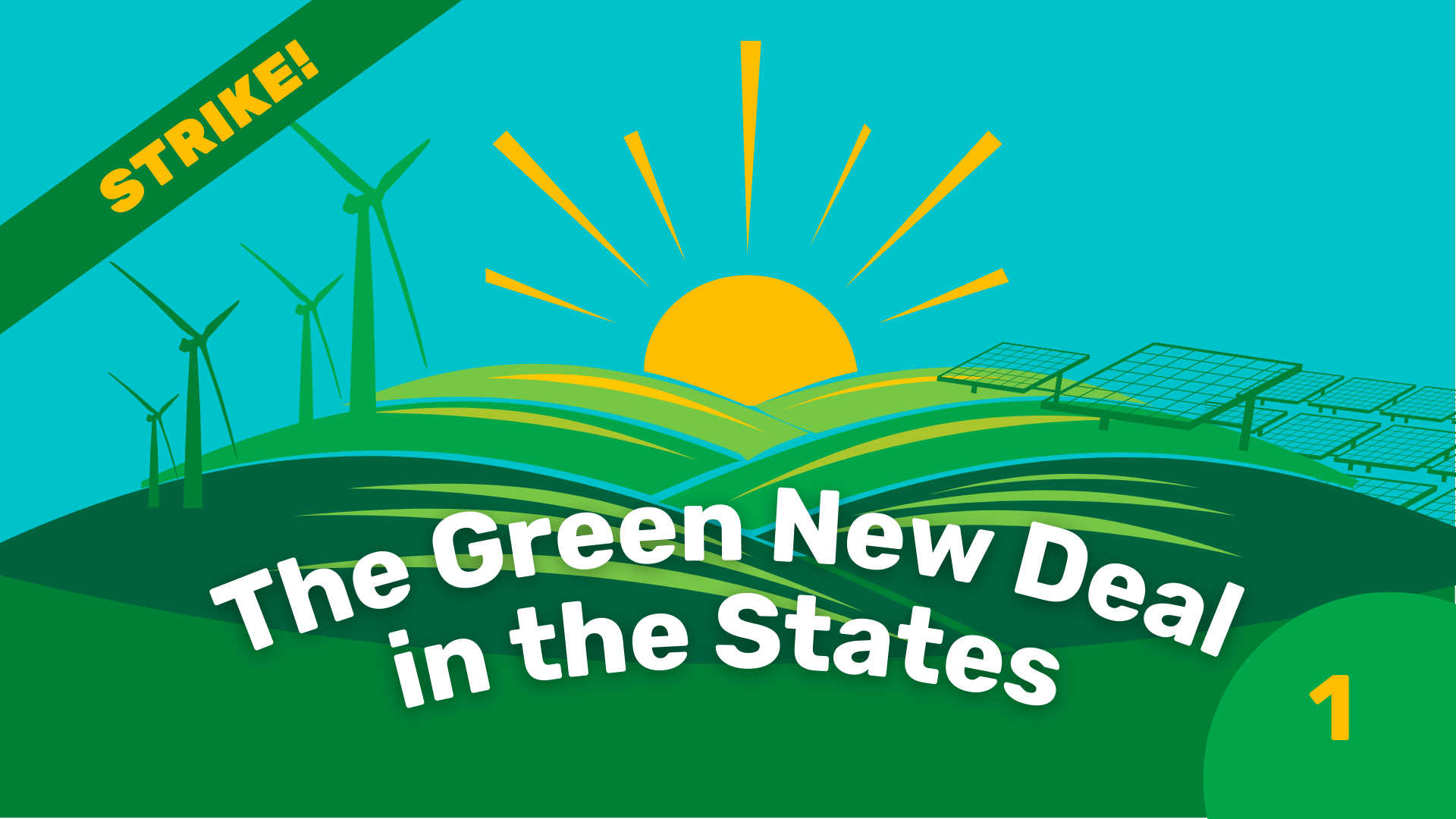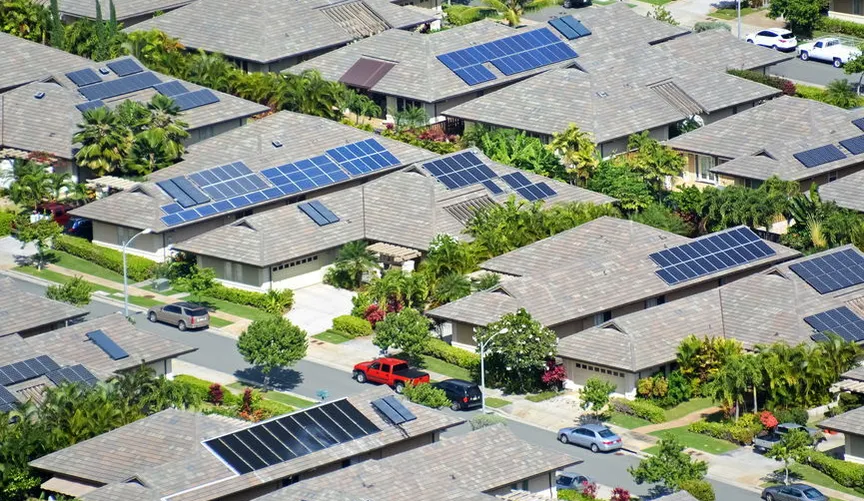Just since the start of 2021 there has been a wave of state legislation and executive action that sets and implements new standards for greenhouse gas emissions. States have greatly expanded their plans for wind and solar energy and energy efficiency. In most cases these are combined with policies specifically designed to create good quality jobs and to counter inequality. This Commentary describes job-creating, justice-promoting climate protection in Hawaii and Illinois. The following Commentary will describe such initiatives in California and evaluate the origins and effects of state-level Green New Deal-style initiatives overall.

States have the power to implement much of the Green New Deal – and some states are using that power. States regulate power generation, local distribution of electricity, and siting decisions. They set the parameters for urban planning and public transit. Most states have adopted renewable portfolio standards that require utilities to use a certain percentage of electricity from renewable sources. Many have adopted policies for energy storage, electric vehicles, energy efficiency standards for appliance and buildings, low carbon fuel standards, and emissions trading. And some are combining such climate protection policies with strategies to create good jobs and overcome longstanding economic and social injustices.
There are organizing efforts for programs that embody the principles of the Green New Deal in every one of the fifty states. In many states some of these policies have already been established and are starting to be implemented. This is largely a result of popular pressure and organization. It also results from politicians trying to appeal to concerned electorates. These victories have typically been produced by coalitions whose objectives combine climate, jobs, and justice.[1]
Hawaii: “A Postcard from the Future”

Rooftop solar on residences in an Oahu neighborhood (Jeremy Bezanger/Unsplash)
In 2015 Hawaii became the first US state to pass a law requiring that all electricity come from renewable energy sources. In 2020, after years of pressure from environmental advocates, the legislature banned the use of coal for producing electricity, effective the end of 2021. The law proclaimed, “The purpose of this Act is to eliminate the use of coal in Hawaii for electricity production.”[2] On September 1, 2022 Hawaii closed its only coal-fired power plant as a step toward its goal of 100% renewable energy by 2045.[3]
Hawaii Electric, an investor-owned utility that supplies all of the electricity on Oahu and most in the rest of Hawaii, already produces more than 30% of its electricity from renewable sources. Hawaii has 14 major solar, battery, or geothermal projects scheduled for completion by 2024. It is emphasizing projects that include battery storage. For example, the Mililani Solar 1, Oahu’s largest solar and storage project, can deliver its 30 megawatts to a battery array that can hold 156 megawatt-hours to use at night. In addition to providing power at demand peaks, the battery will help maintain the stability of the grid by preventing shutdowns and providing rapid restarts. The estimated cost of Mililani’s power is one-third the currently elevated cost of electricity produced by burning oil.[4]
Hawaii long encouraged the development of rooftop solar energy through net metering and incentives for energy exported to the grid. But in 2015, with rooftop solar growing rapidly, the utilities and regulators abolished net metering and ended the incentives, severely limiting new solar installations. But as the deadline for closing the coal plant approached, fear of a power shortage emerged. In response, in 2021 Governor David Ige launched the Powering Past Coal Task Force to ensure a smooth grid transition.[5] While in many locations utilities and rooftop installers each try to limit the others’ development, in the face of impending shortages Hawaii Electric and rooftop solar installers teamed up to support a plan to pay households an upfront cash bonus plus a monthly credit on their bills for adding a battery to their rooftop solar so they can export power to the grid during two hours of peak demand every evening. The result will be a system that expands rooftop, community, and utility-scale solar at the same time.[6]
AES Corporation, which ran the now closed coal-fired power plant, says there were 40 full-time employees working there. The company says it has provided them training for its solar and battery facilities and helped the majority of them to transition to renewable energy positions.[7] Others will work with other companies in the same industrial park; several thermal power plants, for example, use directly transferable skills.[8]
One impediment to the development of solar energy is Hawaii’s shortage of land. Many potential sites are located in communities where plantation workers used to live – and communities often resist development. Renewable energy developer Noelani Kalipi notes that “Hawaii has a long history of developers coming in and promising the world.” Successful solar development requires connecting with communities and actually grappling with the issues that they raise. Building trust as a responsible partner for the community takes time and money. “Money talks, but money doesn’t always win.”[9]
The conversion to renewable energy also has support among indigenous Hawaiians. At the ground-breaking ceremony for the Mililani Solar 1 battery storage project, Kahu Kordell Kekoa, a Hawaiian spiritual leader, said, “Today, we’re going to turn the dirt. But the turning of the dirt is not just for this place; it’s for what will come out of this place. Our children will never know what this looked like. In fact, they won’t even know what a coal station looked like. And what a blessing that is.”[10]
The shutting down of coal and the ramping up of renewable energy is only one aspect of Hawaii’s Green New Deal-style policies summed up in its official “Legal and Statutory Sustainability Targets.”[11] Targets include:
- Locally Produced Food: Double local food production and provide 30% of food served in public schools locally by 2030; 42% of all produce purchased by government departments local by 2045.
- Energy Efficiency Portfolio Standards: Reduce 4,300 gigawatt hours of electricity use by 2030.
- Renewable Portfolio Standard: 40% of net electricity renewable by 2030; 70% by 2040; 100% by 2045.
- Net-Zero Energy Use: All schools net-zero renewable energy by 2035.
- Clean Transportation: State fleet zero emission vehicles by 2030.
A “Green New Deal” bill proposed in the 2021 Hawaii legislature recognized that the work done so far is only a beginning.
Lest Hawaii lose its leadership position in meeting the future of labor, justice, and equity, the legislature embraces Aloha ‘Aina [Native Hawaiian expression literally meaning “love of the land”] as a green new deal to decarbonize Hawaii’s systems of food, energy, and transportation, and to sequester carbon through systems of agriculture, waste management, and ecosystem restoration.[12]
Illinois
How The Illinois Climate and Equitable Jobs Act Was Passed | Author: Chi Hack Night | Watch the video »
In 2016 Illinois passed a widely touted Future Energy Jobs Act. It set a target of 25 percent renewable energy by 2025; allocated $5 billion for energy efficiency; and provided access to solar energy and job training in low-income and environmental justice communities. The campaign for the law was largely led by the Illinois Clean Jobs Coalition, which included the state’s major environmental groups along with hundreds of environmental justice, community-based, labor, faith and public health organizations. But according to in-depth reporting by political scientist and activist Sarah Spengeman, the law was largely written by “energy industry insiders and policy experts” with little opportunities for “workers or marginalized populations” to “identify their needs or voice concerns.”[13]
The legislation sparked a boom in solar energy, but according to Spengeman it failed to achieve its job quality and economic justice goals. It “failed to include labor standards protecting clean energy workers” or “a just transition plan for displaced fossil fuel workers.” It also neglected to “fund outreach or programs to ensure any newly created capital would benefit those historically excluded from opportunities for wealth creation.”
According to Illinois AFL-CIO Secretary-Treasurer Pat Devaney, “We don’t have to speculate about what would happen without labor standards; we have a case study in FEJA.” The law had “no labor standards” and “what we saw throughout all sectors of renewable energy development” was “out-of-state contractors bringing in out-of-state workers, with no benefit to the Illinois workforce or union workforce.”[14]
In 2018 the Illinois Clean Jobs Coalition decided to draft a new bill – this time through a highly participatory process dubbed “Listen, Lead, Share” — that would result in a law “written by communities for communities.” They set broad goals: 100% clean energy, clean transportation, job creation, and a just transition. Then they launched hundreds of community “listening sessions” in all 59 state legislative districts with emphasis on environmental justice and community-based organizations. A quarter million dollars was provided to dozens of small organizations to support their capacity to participate. Thousands of people gave their input. The listening sessions were held in religious congregations, school gymnasiums, and recreation centers, ranging from small focus groups of five people to full auditoriums. They “sought out people’s real challenges and worries for the clean energy transition” and gathered ideas for “solutions, programs, and investments” to ensure that “the transition’s benefits were felt equally.”
After the bill was drafted, the Clean Jobs Coalition held two more rounds of listening sessions to be sure it corresponded to what the grassroots wanted. This had the additional benefit of recruiting informed and committed support.
Meanwhile, Illinois labor unions established a separate Climate Jobs Illinois coalition which campaigned for its own Clean Union Jobs Act. It required employers receiving state aid to: pay the region’s prevailing wage; agree to remain neutral in the face of any unionization drives; follow fair-bidder standards; and negotiate project labor agreements.[15]
After months of difficult negotiations between these two coalitions and numerous other players, the Illinois legislature passed the Climate and Equitable Jobs Act, incorporating large parts of both coalitions’ bills. It sharply reduces carbon emissions while advancing equity, justice, and quality jobs. Journalist Liza Featherstone calls the legislation a “Green New Deal” for Illinois.[16]
The Act commits Illinois to zero-carbon electricity by 2045 and a net-zero carbon economy by 2050. Its renewable portfolio standard will require 40% renewable electricity by 2030 and 50% by 2040. Renewable energy subsidies will double to $580 million per year, with nearly one-third of the funds designated for community-based and brownfield solar projects. Rooftop solar funding for low-income homeowners and renters, public buildings, and environmental justice nonprofits will increase from $10 million to $50 million a year. All private coal- and oil-fired power plants must reach zero emissions – tantamount to retirement – by 2030, and municipally owned power plants must reduce emissions 45% by 2035 and 100% by 2045. Private natural gas plants must freeze their emissions immediately and shut down by 2045. Nuclear power plants were provided a subsidy and permitted to remain open for the next five years. A “green bank” called the Illinois Finance Authority Climate Bank will provide seed funding and seek private investment for green projects. Every five years state agencies must report on progress toward renewable energy goals.
The act set a goal of one million electric vehicles on the road by 2030. It provides rebates of $4,000 per vehicle for electric cars and light trucks. The state will rebate up to 80% of the costs of electric vehicle infrastructure for projects that pay prevailing wages. 45% will go to low-income and marginalized communities.
The Act closely integrates justice provisions with its climate policies. For example:
- the first fossil fuel plants to be shut down will be those nearest to low-income and marginalized communities.
- The law requires diversity reporting for renewable projects and for the entire industry.
- It allocates $80 million for Clean Jobs Workforce Network Hubs run by local organizations in 13 of the state’s low-income communities to deliver outreach, recruitment, training, and placement for climate jobs.
- It provides travel stipends, work clothes, tools, and/or childcare for training and incubator program participants.
- A program will train and place people currently in prison for clean energy jobs.
- A Clean Energy Jobs and Justice Fund will fund projects in low-income and marginalized communities.
- $35 million a year is allocated for a clean energy incubator program for small energy businesses.
Many of these proposals emerged from the listening sessions organized by the Clean Jobs Coalition.
The Act also integrates the main labor rights and standards policies advocated by the Climate Jobs Coalition into its climate provisions. Utility-scale solar and wind projects must establish project labor agreements. All non-residential projects must pay prevailing wages. The Act is estimated to create 50,000 construction jobs over the next ten years.
Recognizing that the transition to a climate-safe economy may produce dislocation and hardship, The Act:
- provides protection and support for workers and communities who it may affect adversely.
- It requires companies shutting down fossil fuel plants to inform affected communities two years in advance.
- It provides reinvestment in adversely affected communities, committing $47 million annually to convert coal power plants to solar farms or energy storage facilities, $40 million per year to compensate communities for lost property taxes, and economic development and job training in communities where mines or power plants are closed.
- And the Act establishes a “Displaced Energy Workers Bill of Rights” which allocates $40 million to create jobs for laid-off workers by constructing solar and storage facilities on closed fossil-fuel plant sites.
The Act also promotes democratic control and accountability. For example, it establishes new ethical standards for utilities and creates a Public Utility Ethics and Compliance Monitor to enforce them. And it requires utilities to fund the participation of nonprofit representatives in regulation proceedings.
Climate journalist David Roberts says the Act’s “comprehensive package of labor, diversity, and equity standards” embodies “the most stringent labor and equity requirements of any state clean energy program.” The bill passed in part because “every group gave a little to get a lot.” He especially singles out the Illinois environmental-justice community, which used “three years of relentless grassroots organizing” to build “an incredible political force” and “without which the bill couldn’t have passed and wouldn’t have been as equity-focused.”
The impact of the Climate and Equitable Jobs Act is already visible on the ground. According to the Illinois Solar Energy Industries Association, five months after the passage of the Act solar businesses have installed enough renewable energy to power 30,000 homes, an increase due in large part to the Act. The solar industry expects to increase its Illinois workforce by almost 50% in 2022. The industry says it is increasing its diversity, equity, and inclusion by “recruiting from solar job training programs, creating internal committees focused on diversity and hiring consultants and recruiters to guide their diversity efforts.”[17]
The next commentary, “The Green New Deal in the States – Part 2,” will examine the comprehensive climate, jobs, and justice programs instituted this year by California and evaluate the current and potential role of states in creating a Green New Deal from Below.
[1] for reviews of climate policies by state:
https://climate-xchange.org/mission-impact/
https://www.c2es.org/content/state-climate-policy/
http://www.usclimatealliance.org/state-climate-energy-policies
https://climate.law.columbia.edu/content/state-and-local-climate-change-resource-center
https://spotforcleanenergy.org
[2] Julian Spector, “Hawaii has a one-year deadline to ditch coal,” Canary Media, October 25, 2021. https://www.canarymedia.com/articles/clean-energy/hawaii-has-a-one-year-deadline-to-ditch-coal
[3] Hallie Golden, “Hawaii to close its only coal power plant in a step toward renewable energy,” Guardian, August 31, 2022. https://www.theguardian.com/us-news/2022/aug/31/hawaii-close-coal-power-plant-renewable-energy
[4] Julian Spector, “Hawaii’s biggest solar+battery plant comes online,” Canary Media, August 15, 2022. https://www.canarymedia.com/articles/solar/hawaiis-biggest-solar-battery-plant-comes-online-just-in-time
[5] Julian Spector, Ibid.
[6] Julian Spector, “People power: Hawaii utility wants to pay households,” Canary Media, February 14, 2022. https://www.canarymedia.como /articles/batteries/people-power-hawaii-utility-wants-to-pay-households-to-share-clean-energy
[7] Hallie Golden, “Hawaii to close its only coal power plant in a step toward renewable energy,” The Guardian, August 31, 2022. https://www.theguardian.com/us-news/2022/aug/31/hawaii-close-coal-power-plant-renewable-energy#new_tab
[8] Julian Spector, “Hawaii is about to get rid of coal power for good,” Canary Media, August 22, 2022. https://www.canarymedia.com/articles/fossil-fuels/hawaii-is-about-to-get-rid-of-coal-power-for-good
[9] Julian Spector, “Hawaii has a one-year deadline to ditch coal,” Canary Media, October 25, 2021. https://www.canarymedia.com/articles/clean-energy/hawaii-has-a-one-year-deadline-to-ditch-coal
[10] Julian Spector, “Hawaii building huge new battery, bidding farewell to coal,” Canary Media, August 18, 2021.
[11] “Hawai’i 2050 Sustainability Plan,” Hawaii State Office of Planning, June 2021, p. 15. https://hawaii2050.hawaii.gov/wp-content/uploads/2021/07/FINAL-Hawaii-2050-Sustainability-Plan-web-1.pdf
[12] H.B. No. 2487, “Relating to a Hawaii Green New Deal,” https://www.capitol.hawaii.gov/session2020/bills/HB2487_.HTM
[13] The inside account of organizing for the legislation is based on Sarah Spengeman, “Illinois’ Climate and Equitable Jobs Act Is a Roadmap for Climate Justice Policy,” Stamford Social Innovation Review, March 24, 2022. https://ssir.org/articles/entry/legislating_for_climate_justice_starts_with_listening and Sarah Spengeman, “A Bigger Tent Delivers Stronger Wins for Climate: The Lesson From Illinois,” The Revelator, January 14, 2022. https://therevelator.org/bigger-tent-climate-illinois/
[14] Kari Lydersen, “Union-backed bill calls for prevailing wage for Illinois renewable projects,” Energy News Network, April 14, 2021. https://energynews.us/2021/04/14/union-backed-bill-calls-for-prevailing-wage-for-illinois-renewable-projects/
[15] Lydersen, Ibid.
[16] Liza Featherstone, “Illinois Just Won a Big Green Jobs Victory,” Jacobin, September, 2021.
https://jacobin.com/2021/09/illinois-green-new-deal-jobs-labor-nuclear
[17] “Illinois Renewable Energy Growth Surges in the Months After Climate and Equitable Jobs Act Signed,” Solar Energy Industries Association Press Release, February 15, 2022. https://www.seia.org/news/illinois-renewable-energy-growth-surges-months-after-climate-and-equitable-jobs-act-signed

